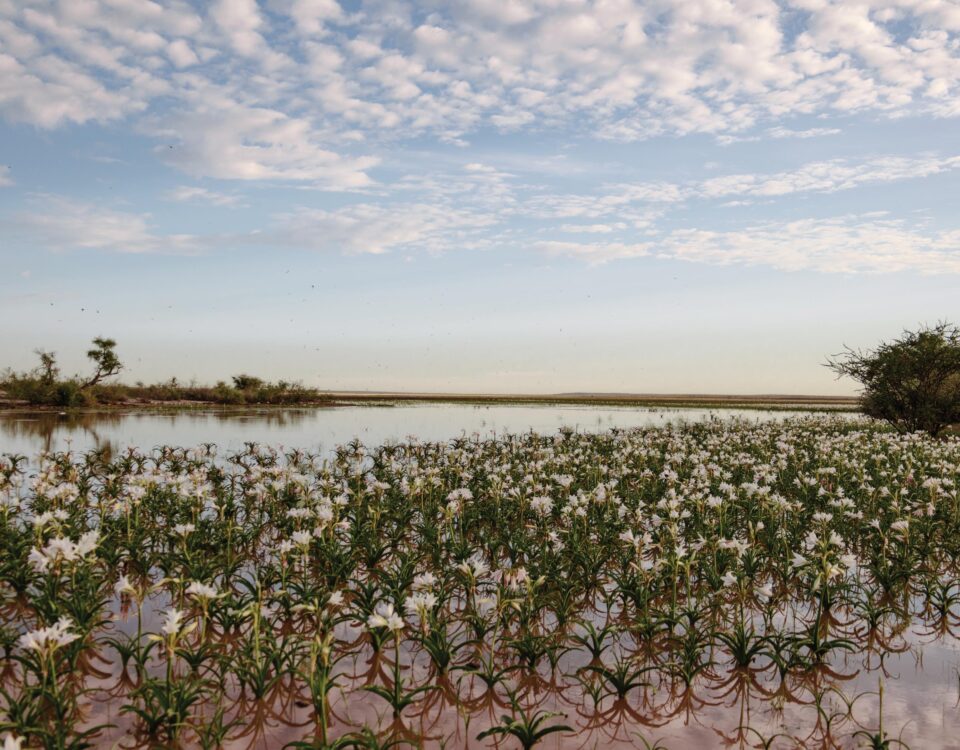Air Namibia explores new skies
August 14, 2012Catty patty cakes
August 14, 2012Text and photographs Luise Hoffmann
Travel anywhere in the northern half Namibia these days and you’ll find the roads lined with dense stands of bright golden-yellow flowers spreading far into the bordering farmlands.
In some years it’s a fairly common phenomenon that certain plants are prevalent along roads and on disturbed soil. The current explosion of the so-called John-Deere flower (Nidorella resedifolia) – aptly named after the similar colours sported by John Deere tractors – is quite spectacular. When viewed from an aircraft, the country looks positively golden yellow.
The John Deere flower was quite common around Windhoek last year, and in some areas it makes its appearance every summer. I remember picking these flowers in the veld as a child on our farm in the Otavi Mountains, and in later years on our own farm north of the Waterberg. My father had formulated a little poem proclaiming that all living creatures existed for the glory of the Lord, but this particular plant was far too prevalent to his tastes. So even in those days they were abundant in certain years. Several farmers confirmed that very wet rainy seasons are usually followed the next year by the appearance of various weeds in large numbers.
When hunting around for common names, I encountered ‘poverty’. While these flowers apparently do not encroach on perennial grasses, they do seem to crowd out the annual ones. On disturbed soils, which usually support hardly any perennial grasses, this means less fodder for grazers such as game, cattle and sheep, resulting in lower income and in this case ‘poverty’ for farmers.
The German name for the plant is Nesterkraut, meaning ‘nest herb’, but when looking for the origin of this name, I was again confronted by ‘poverty’.
The so-called John Deere flower (Nidorella resedifolia) or Nesterkraut is a composite flower like the sunflower or daisy, with the difference that it consists of fertile disc flowers only. It is indigenous to Namibia and the Okavango Delta, and probably also occurs elsewhere in Southern Africa. It doesn’t seem to be browsed to any extent and no other uses are mentioned in the literature or on the Internet.
Why this explosion of the John Deere flower? Namibia has experienced several consecutive good rainy seasons, during which these plants flowered more than once and thus produced much larger quantities of seed than in normal years. The seeds are tiny, very numerous and are distributed by the wind. The life cycle of Nidorella resedifolia has not been studied closely, and it is still not clear why it suddenly occurs in such large numbers.
The massive occurrence of a very delicate little lobelia in September 2011, before any rains had fallen, was even more astonishing. Suddenly they sprouted from the hard and apparently completely dry soil – little herbs with reddish stems and just a few reddish leaves at the base, no more than about 30 centimetres high.
These fragile little flowers formed large patches of an intense royal blue, clearly visible from the air, along the roads from Karibib to Gobabis and as far north as Otjiwarongo. In the past three years I have spent much time walking around in the bush, taking photographs of the flowers I saw, but I never came across this little lobelia, which is quite similar to the one available in nurseries and found in many gardens. Then suddenly, after the rainy season 2010/2011, they appeared in large numbers.
This article appeared in the April 2012 edition of FLAMINGO Magazine.


